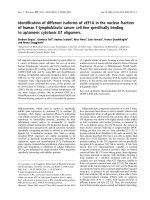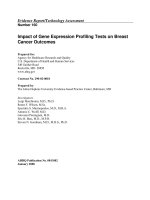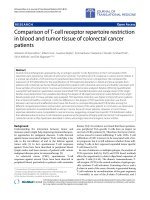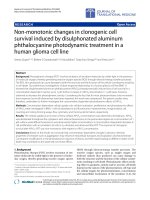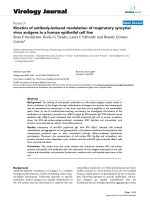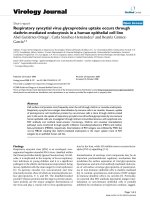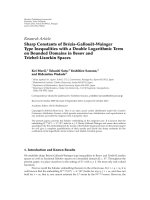UTILIZATION OF A CANINE CANCER CELL LINE (FACC) PANEL IN COMPARATIVE AND TRANSLATIONAL STUDIES OF GENE EXPRESSION AND DRUG SENSITIVITY
Bạn đang xem bản rút gọn của tài liệu. Xem và tải ngay bản đầy đủ của tài liệu tại đây (5.01 MB, 238 trang )
DISSERTATION
UTILIZATION OF A CANINE CANCER CELL LINE (FACC) PANEL IN COMPARATIVE
AND TRANSLATIONAL STUDIES OF GENE EXPRESSION AND DRUG SENSITIVITY
Submitted by
Jared S. Fowles
Graduate Degree Program in Cell and Molecular Biology
In partial fulfillment of the requirements
For the Degree of Doctor of Philosophy
Colorado State University
Fort Collins, Colorado
Summer 2015
Doctoral Committee:
Advisor: Daniel Gustafson
Dawn Duval
Ann Hess
Douglas Thamm
Michael Weil
Copyright by Jared Scott Fowles 2015
All Rights Reserved
ABSTRACT
UTILIZATION OF A CANINE CANCER CELL LINE (FACC) PANEL IN COMPARATIVE
AND TRANSLATIONAL STUDIES OF GENE EXPRESSION AND DRUG SENSITIVITY
Canine cancer is the leading cause of death in adult dogs. The use of the canine cancer
model in translational research is growing in popularity due to the many biologic and genetic
similarities it shares with human cancers. Cancer cell tissue culture has long been an established
tool for expanding our understanding of cancer processes and for development of novel cancer
treatments. With the high rate of genomic advancements in cancer research over the last decade
human cancer cell line panels that combine pharmacologic and genomic information have proven
very helpful in elucidating the complex relationships between gene expression and drug response
in cancer. We have assembled a panel of canine cancer cell lines at the Flint Animal Cancer
Center (FACC) at Colorado State University to be utilized in a similar fashion as a tool to
advance canine cancer research. The purpose of these studies is to describe the characteristics of
the FACC panel with the available genomic and drug sensitivity data we have generated, and to
show its utility in comparative and translational oncology by focusing specifically on canine
melanoma and osteosarcoma.
We were able to confirm our panel of cell lines as being of canine origin and determined
their genetic fingerprint through PCR and microsattelite analyses, creating a point of reference
for validation in future studies and collaborations. Gene expression microarray analysis allowed
for further molecular characterization of the panel, showing that similar tumor types tended to
cluster together based on general as well as cancer specific gene expression patterns. In vitro
ii
studies that measure phenotypic differences in the panel can be coupled with genomic data,
resulting in the identification of potential gene targets worthy of further exploration. We also
showed that human and canine cancer cells are similarly sensitive to common chemotherapy.
Next we utilized the FACC panel in a comparative analysis to determine if signaling
pathways important in human melanoma were also activated and sensitive to targeted inhibition
in canine melanoma. We were able to show that despite apparent differences in the mechanism
of pathway activation, human and canine melanoma tumors and cell lines shared constitutive
signaling of the MAPK and PI3K/AKT pathways, and responded similarly to targeted inhibition.
These data suggest that studies involving pathway-targeted inhibition in either canine or human
melanoma could potentially be directly translatable to each other.
Evidence of genetic similarities between human and canine cancers led us to ask whether
or not non-pathway focused gene expression models for predicting drug sensitivity could be
developed in an interspecies manner. We were able to show that models built on canine datasets
using human derived gene signatures successfully predicted response to chemotherapy in canine
osteosarcoma patients. When compared to a large historical cohort, dogs that received the
treatement our models predicted them to be sensitive to lived significantly longer disease-free.
Taken together, these studies show that human and canine cancers share strong molecular
similarities that can be used advantageously to develop better treatment strategies in both
species.
iii
ACKNOWLEDGEMENTS
I could not have completed this journey without the help from several individuals. First
and foremost I would like to thank my advisor Dr. Dan Gustafson for his support, guidance, and
willingness to accept a student with no prior research experience into his lab. His ability to keep
me funded and his assistance in shaping the story of my multi-faceted project will forever be
appreciated. I would also like to thank the members of my committee, Drs. Dawn Duval, Ann
Hess, Doug Thamm, and Mike Weil for sharing their knowledge and expertise.
I thank all of my many colleagues that I have been fortunate to associate with through the
years at the Flint Animal Cancer Center. All of them have played a critical role in creating a
work atmosphere that I have thoroughly enjoyed and have benefited from. Special thanks must
go out for those that assisted me in specific experiments of my research project, namely Cathrine
Denton, Ryan Hansen, Liza Pfaff, Barb Rose, Brad Charles, Rebecca Barnard, Deanna Dailey,
Kristen Brown, and Laird Klippenstein.
Much of my research could not have been performed without the support of funded
grants from the CSU Cancer Supercluster and the Morris Animal Foundation, and I thank these
organizations for their commitment to research in comparative oncology.
Lastly, I must thank my family for the unwavering support and love that was absolutely
irreplaceable to me during this journey of professional and personal development. I thank my
father and mother John and Debbie Fowles for always believing in me and helping me realize my
potential. I thank my wonderful wife Jessie and our four children Emma, Scott, Madellyn, and
Clara for the joy and balance they bring to my life and for their amazing patience with me as I
pursued my degree. I will be forever grateful to all who helped me arrive at this point in my life.
iv
TABLE OF CONTENTS
ABSTRACT .................................................................................................................................... ii
ACKNOWLEDGEMENTS ........................................................................................................... iv
LIST OF TABLES ........................................................................................................................ vii
LIST OF FIGURES ..................................................................................................................... viii
Chapter 1: Literature Review
Canine Cancer as a Model
Canine cancer statistics ..........................................................................................................1
History of veterinary oncology ..............................................................................................2
Advantages of the canine cancer model.................................................................................5
Disadvantages of the canine cancer model ............................................................................7
Cancer is a molecular disease
Role of genomic instability and mutation in cancer ..............................................................8
Oncogenes and tumor suppressors .......................................................................................12
Signaling pathways important for cancer ............................................................................16
Molecularly targeted agents for cancer therapy ...................................................................19
Comparative Oncology of Melanoma
Epidemiology of human and canine melanoma ...................................................................22
Comparative biology of melanoma ......................................................................................23
Comparative genetics and molecular biology of melanoma ................................................25
Treatment of human and canine melanoma .........................................................................27
Comparative oncology of osteosarcoma
Epidemiology of human and canine osteosarcoma ..............................................................34
Comparative biology of osteosarcoma.................................................................................37
Comparative genetics and molecular biology of osteosarcoma ...........................................40
Treatment of human and canine osteosarcoma ....................................................................45
Predicting response to therapy in individual patients
Role of biomarkers in cancer ...............................................................................................57
Multi-gene signatures of drug response ...............................................................................61
PROJECT RATIONALE ...............................................................................................................65
REFERENCES ..............................................................................................................................70
Chapter 2: The Flint Animal Cancer Center (FACC) Canine Tumor Cell Line Panel: A Resource
for Veterinary Drug Discovery, Comparative Oncology and Translational Medicine
SUMMARY .......................................................................................................................109
INTRODUCTION .............................................................................................................109
MATERIALS AND METHODS .......................................................................................112
RESULTS ..........................................................................................................................117
DISCUSSION ....................................................................................................................134
REFERENCES ..................................................................................................................137
v
Chapter 3: Comparative Analysis of MAPK and PI3K/AKT Pathway Activation and Inhibition
in Human and Canine Melanoma
SUMMARY .......................................................................................................................143
INTRODUCTION .............................................................................................................144
MATERIALS AND METHODS .......................................................................................148
RESULTS ..........................................................................................................................155
DISCUSSION ....................................................................................................................169
REFERENCES ..................................................................................................................174
Chapter 4: Gene Expression Models for Predicting Drug Response in Canine Osteosarcoma
SUMMARY .......................................................................................................................179
INTRODUCTION .............................................................................................................179
MATERIALS AND METHODS .......................................................................................183
RESULTS ..........................................................................................................................188
DISCUSSION ....................................................................................................................211
REFERENCES ..................................................................................................................215
Chapter 5: General Conclusions and Future Directions
GENERAL CONCLUSIONS ............................................................................................220
FUTURE DIRECTIONS ...................................................................................................224
REFERENCES ..................................................................................................................228
vi
LIST OF TABLES
Chapter 2
Table 2.1 Current cell lines within the FACC panel ....................................................................114
Table 2.2 Allelic sizes of the commonly used cell lines as determined using the Canine
Stockmarks Genotyping Kit .........................................................................................................118
Table 2.3 Differentially expressed genes between fast and slow migration/invasion osteosarcoma
cell lines .......................................................................................................................................130
Table 2.4 Differentially expressed pathways between fast and slow migration/invasion
osteosarcoma cell lines ................................................................................................................133
Chapter 3
Table 3.1 Microarray setup for gene expression analysis ............................................................149
Table 3.2 Primer sequences for PCR ...........................................................................................151
Table 3.3 Mutational analysis of human and canine melanoma ..................................................161
Table 3.4 Sensitivity of human and canine melanoma cells to AZD6244 and/or rapamycin .....165
Chapter 4
Table 4.1 Datasets used in study ..................................................................................................190
Table 4.2 COXEN models using 5 classification mehods and 3 probeset matching strategies
......................................................................................................................................................193
Table 4.3 COXEN modeling results for doxorubicin sensitivity.................................................199
Table 4.4 COXEN modeling results for carboplatin sensitivity ..................................................201
Table 4.5 Genes from best COXEN models for doxorubicin and carboplatin response in COS33 ..
......................................................................................................................................................207
Table 4.6 Factors associated with disease free interval (DFI) of COS33 patients in a multivariate
analysis .........................................................................................................................................211
vii
LIST OF FIGURES
Chapter 2
Figure 2.1 Correlations of cancer genes between Canine 2.0 and 1.0 ST arrays. ........................120
Figure 2.2 Principal Component Analysis of the FACC panel ....................................................121
Figure 2.3 Cluster analysis using the Top 100 most variant genes separates the samples into
groups with similar histiotypes ....................................................................................................123
Figure 2.4 Cluster analysis using the Top 100 most variant cancer genes separates the samples
into groups with similar histiotypes and may identify critical genetic drivers ............................125
Figure 2.5 Human and canine cancer cells are similarly sensitive to chemotherapy ..................127
Figure 2.6 Migration and invasion of osteosarcoma cell lines ....................................................129
Chapter 3
Figure 3.1 Differential expression of MAPK pathway in human and canine melanoma versus
normal tissue ................................................................................................................................156
Figure 3.2 Differential expression of PI3K/AKT pathway in human and canine melanoma versus
normal tissue ................................................................................................................................157
Figure 3.3 Human and canine melanoma share differential expression patterns with regard to
ERK/MAPK and PI3K/AKT signaling pathways........................................................................159
Figure 3.4 Constitutive activation of MAPK and PI3K/AKT pathways in human and canine
melanoma cell lines......................................................................................................................162
Figure 3.5 Human and canine melanoma cell lines are similarly sensitive to MAPK and
PI3K/AKT pathway inhibition.....................................................................................................164
Figure 3.6 Combined inhibition of MAPK and PI3K/AKT pathways is synergistic in human and
canine melanoma cells .................................................................................................................166
Figure 3.7 Cell cycle analysis of human and canine melanoma cells after AZD6244 and/or
rapamycin treatment.....................................................................................................................168
Chapter 4
Figure 4.1 The COXEN method ..................................................................................................189
viii
Figure 4.2 Human and canine drug sensitivity is comparable .....................................................190
Figure 4.3 Selecting a probeset matching strategy ......................................................................191
Figure 4.4 Human and canine cell line gene signatures for doxorubicin accurately sort
osteosarcoma samples ..................................................................................................................195
Figure 4.5 In vitro human COXEN models predict canine cell line sensitivity to doxorubicin ..197
Figure 4.6 In vitro human COXEN models predict canine cell line sensitivity to carboplatin ...198
Figure 4.7 Cell line-trained COXEN models on clinical outcome of COS49 .............................200
Figure 4.8 Cell line-trained models on clinical outcome in doxorubicin-treated COS33 ...........202
Figure 4.9 Cell line-trained models on clinical outcome in carboplatin-treated COS33 .............203
Figure 4.10 In vivo COXEN models predict clinical outcome in doxorubicin-treated canine
osteosarcoma patients ..................................................................................................................205
Figure 4.11 In vivo COXEN models predict clinical outcome in carboplatin-treated canine
osteosarcoma patients ..................................................................................................................206
Figure 4.12 Combined effects of doxorubicin and carboplatin COXEN models on clinical
outcome of canine osteosarcoma patients receiving combination treatment ...............................209
Figure 4.13 Effect of COXEN matching on clinical outcome of canine osteosarcoma patients
receiving single agent and combination treatment.......................................................................210
ix
CHAPTER 1
Literature Review
CANINE CANCER AS A MODEL
Canine cancer statistics
Cancer is the second leading cause of human death in the United States, with a 2014
study estimating 1,665,540 new diagnosed cases and 585,720 deaths each year (American
Cancer Society, 2014). Advancements in health care for companion animals in recent years
including better vaccines, diet, the implementation of leash laws, and better diagnostic tools have
resulted in longer living pets, leading to increases in age-related disease such as cancer (Paoloni
and Khanna, 2007). Of the estimated 65 million dogs in the United States, cancer is the leading
cause of death in adult dogs, reaching 45% in of dogs 10 years or older. An estimated 6 million
new cancer diagnoses are made in the population each year (Mazcko, 2012; O'Donoghue et al.,
2010; Ranieri, 2013). Put more simply, it is estimated that 1 in 2 dogs will get cancer, and 1 in 4
dogs will die from cancer, showing that similar to humans the pet dog population is deeply
impacted by this disease and is in need of continued support in developing new and better ways
of combating cancer (Paoloni and Khanna, 2007).
Dogs get many of the same cancers as humans, including osteosarcoma, melanoma, nonHodgkin’s lymphoma, leukemia, soft tissue sarcoma, as well as cancers of the prostate, lung,
bladder, head and neck, and breast (Bergman, 2007; Caserto, 2013; Fenger et al., 2014; Ito et al.,
2014; Knapp et al., 2014; Paoloni and Khanna, 2007; Porrello et al., 2006; Richards and Suter,
1
2015). According to a UK study, malignant tumors with the highest incidence are mast cell
tumors followed by soft tissue sarcoma, lymphoma, osteosarcoma, and mammary tumors
(Dobson, 2013). Certain breeds have been associated with a higher risk of developing specific
cancers. For example, Rottweiler, Irish Wolfhound, and Great Dane breeds are at higher risk to
develop osteosarcoma (Dobson, 2013). Bull Terrier, Boxer, Golden and Labrador Retriever, and
Bulldog breeds are at a higher risk to develop mast cell tumors (Dobson, 2013). Golden
Retrievers are also at high risk for developing other cancers such as lymphoma, oral melanoma,
fibrosarcoma, and histiocytic tumors, resulting in the reported cancer death rate of 60% for this
more susceptible breed (Dobson, 2013; Hovan, 2006).
History of veterinary oncology
The relatively new field of veterinary oncology has advanced steadily since its
beginnings more than 50 years ago. In 1958 a veterinarian named Gordon Theilen wrote a report
describing a herd of cattle where multiple leukemias were observed (Theilen, 2013). This was
the start of his very influential path as a pioneer for this emerging field. A few years later in
1962 the New York Academy of Science sponsored a meeting entitled “Tumors in Animals”
where Dr. Theilen and others presented papers describing animal cancers. From that point on a
small group of research and clinical veterinarians began to meet to discuss their interests in
animal cancers, eventually leading to the creation of the Veterinary Cancer Society (VCS) in
1977 (Paoloni and Khanna, 2007; Theilen, 2013). The decade before another group called the
International Association for Comparative Research on Leukemia and Related Diseases
(CRLRD) was created whose primary interest was in studying the basic mechanisms and
relations between viruses and cancer in different species including birds, rodents, and mammals
(Theilen, 2013). In 1972 at UC Davis Dr. Theilen helped develop the first veterinary cancer
2
medicine specialty program (Theilen, 2013). In 1988 Medical Oncology was officially added to
the American College of Veterinary Internal Medicine (ACVIM). Alice Villalobos, a former
veterinary student under Dr. Theilen at UC Davis, was responsible for establishing the first
veterinary practice that was strictly devoted to cancer treatment in southern California called the
“Animal Oncology Consultation Service and Animal Cancer Center” (Theilen, 2013). Now
there are similar animal cancer centers established all over the world.
One animal cancer center in particular at Colorado State University (CSU) got its start
thanks to the efforts of two more pioneers: Dr. Ed Gillette, a veterinarian and radiation biologist,
and Dr. Steve Withrow, a veterinary surgeon (Flint Animal Cancer Center, 2014; Theilen, 2013).
Starting in the late seventies they hypothesized that they could treat animals with cancer using
strategies similar to those used in people. They also hypothesized that the spontaneous cancers
arising in dogs would make an effective translational model for human cancer based on the many
similarities of tumors between species. After years of hard work the CSU Flint Animal Cancer
Center (FACC) was finally established in 2002 (Flint Animal Cancer Center, 2014). Today, the
FACC is now recognized all over the world as a leader in cancer research and clinical veterinary
oncology, with a strong research program in multiple areas such as radiation oncology,
molecular genetics, pathology, immunology, pharmacology, musculoskeletal oncology, and
experimental therapeutics (Flint Animal Cancer Center, 2014). The FACC also has a large
clinical team with expertise in medicine, radiation, and surgical oncology that offers high quality
care for animals with cancer (Flint Animal Cancer Center, 2014).
Another advantageous development in veterinary oncology was the launching of the
Comparative Oncology Program (COP) by the National Cancer Institute’s Center for Cancer
Research (CCR) in 2003 (Mazcko, 2012). Its focus is to increase understanding of cancer
3
biology and to improve the development of novel human cancer treatments by incorporating pet
animals into the process. One way that the COP accomplishes this is through the management
of the Comparative Oncology Trials Consortium (COTC), a network of 20 comparative
oncology centers that design and carry out clinical trials in canine cancer patients. The resulting
data from these canine clinical trials are utilized in the design of human phase I and II clinical
trials (Mazcko, 2014).
In anticipation of the completion of the Canine Genome Project in 2005 where 99% of
the canine genome consisting of 2.5 billion base pairs was sequenced, a group of veterinary and
medical oncologists, geneticists, biologists, and pathologists gathered in 2004 in Boston to share
their interest in comparative research of human and canine genomics as it relates to cancer. The
group was established in 2006 and was named the Canine Comparative Oncology and Genomics
Consortium (CCOGC) (Canine Comparative Oncology & Genomics Consortium, 2015;
Lindblad-Toh et al., 2005). One of its priorities was to develop a biospecimen repository which
would contain tumor, normal tissue, blood, and urine samples. Currently the Pfizer CCOGC
Biospecimen Repository has limited the collection to certain cancers with a high comparative
value with human cancers, namely lymphoma, osteosarcoma, melanoma, hemangioma, lung
cancer, soft tissue sarcoma, and mast cell tumors (Canine Comparative Oncology & Genomics
Consortium, 2015).
Currently there are ten veterinary institutions in the United States
participating as collection sites for this repository, which provides samples for investigators all
over the world (Lana, 2014).
Interestingly, the FACC, which is included in this group of collection sites used by the
CCOGC, established its tissue archiving program 3 years prior in 2003. Today more than 21,000
samples of tissue, blood and urine for both canine and feline cancers have been collected in the
4
archive which is an impressive resource for researchers from around the world (Lana, 2014).
Genomic studies in veterinary and comparative oncology are now emerging with force thanks to
genomic advances and the recent availability of tumor samples.
Before this new field of veterinary oncology had begun to gain traction, the only
treatment option for animals with cancer was surgical excision of the tumor, and if that failed to
cure, euthanasia (Theilen, 2013). Thankfully, today along with surgical oncology there are many
more options available to canine cancer patients including chemotherapy, radiation therapy,
immunotherapy, and molecular targeted therapy (Withrow, 2013). Veterinary oncology has come
a long way in a short time, spurred on by ever growing interest in advancing health care for
animals with cancer, and by the increasing number of studies showing that cancers in companion
animals (specifically pet dogs) share many of the same characteristics as human cancers. The
more we learn of companion animal models of cancer the more potential is apparent for
translational applications for human research.
Advantages of the canine cancer model
Murine models have been and continue to be invaluable in studying the biology behind
cancer initiation, promotion, and progression (Ranieri, 2013). However, other aspects of human
cancers are better represented by a canine cancer model. One of the most notable advantages is
the fact that the tumors in pet dogs arise spontaneously which represents the human condition
much more closely than many murine models where tumors are artificially introduced through
transplantation or genetic manipulation (Withrow, 2013). Dogs also are exposed to similar
environmental risk factors by living in the same conditions as their owners and may reflect any
epidemiological changes observed in human cancer development (Dobson, 2013; Withrow,
2013). Canine tumors have similar histology to human tumors, they grow within the context of
5
an intact immune system, and they display tumor heterogeneity between individuals and within
the tumor itself.
This heterogeneity leads to issues of cancer resistance, recurrence, and
metastasis in the dog as is seen in human cancer (Ranieri, 2013; Withrow, 2013).
The larger body size of dogs compared to rodents holds many advantages as well.
Repeated sample collection over time from the same animal is possible in the dog, whereas in
most murine models the sacrifice of multiple animals is needed to form a composite collection of
samples representing different time points. Larger tumor size allows for more tissue and/or
blood to be available for molecular analysis. Larger body size is also important in achieving a
drug dose in dogs that is more comparable to doses given to people (Withrow, 2013).
Canine cancer shares high genetic similarity with the human disease. Genetic lineages
between dogs and humans are more similar than rodents in terms of nucleotide divergence as
well as genetic rearrangements (Paoloni and Khanna, 2007). Many of the cancer-driving genes
in humans are also found to play roles in canine cancers (Withrow, 2013). For example, the
same TP53 alterations that have been documented in human breast cancers, sarcomas and
lymphomas have also been reported in the same cancers in the dog (Haga et al., 2001; Hershey et
al., 2005; Setoguchi et al., 2001).
Another example is found in v-Kit Hardy-Zuckerman 4
Feline Sarcoma Viral Oncogene Homolog (c-Kit), a tyrosine kinase growth factor receptor which
is known to have activating mutations in human gastrointestinal stromal tumors as well as canine
mast cell tumors. Despite the differences in tumor type, the common mechanism of mutant c-Kit
activation allows studies targeting this known cancer pathway to be translatable between species
(Da Ros et al., 2014; London et al., 1999; Pryer et al., 2003; Yamamoto and Oda, 2015). A
cluster analysis of gene expression profiles of canine and human osteosarcoma and
corresponding normal tissues resulted in the separation of normal tissues by species, but
6
interspersion of all osteosarcoma samples regardless of species, showing the genetic similarities
between the cancers of human and dog are more similar to each other than their normal tissue
counterparts (Paoloni et al., 2009). Genetic similarities between human and dog cancers have
also been reported for lymphoma, breast, soft tissue sarcoma, and glioma (Mudaliar et al., 2013;
Paoloni and Khanna, 2008; Uva et al., 2009).
Another advantage of the pet dog model of cancer is the availability of veterinary clinical
trials. Since there is a lack of “standard of care” for the treatment of canine cancer patients,
novel therapies can be administered in a trial setting before other known treatments have failed
(Vail and MacEwen, 2000; Withrow, 2013). Veterinary clinical trials can occur in a preInvestigational New Drug (IND) setting, requiring less paperwork and time for approval. The
cost of clinical trials in companion animals is significantly less than for human trials, and high
levels of owner compliance is advantageous for the quick populating of trials (Vail and
MacEwen, 2000). The shorter time frame associated with the life span of dogs and cancer
progression allows researchers to generate and analyze data as early as 6-18 months in dog trials,
hastening results needed to increase cancer knowledge for dogs with potentially translational
conclusions (Paoloni and Khanna, 2007).
Disadvantages of the canine cancer model
Although the larger body size is amenable to repeated sample collection and achieving
doses nearer to what’s possible in humans, it also means higher quantities of drug are needed
compared to rodent models and thus higher costs (Gordon and Khanna, 2010). The life span of
dogs allows data to be generated much faster than in humans, but studies in dogs are also much
slower to complete than rodent models (Paoloni and Khanna, 2008). Studies with pet dogs in a
clinical trial setting are by nature “uncontrolled” compared to rodent studies making it more
7
difficult to confidently associate toxicity with the drug under investigation. Also, attempts to
bring more control into clinical trials by increasing study entry requirements to reduce the
number of clinical variables can make the study model less similar to the human population it is
meant to reflect (Paoloni and Khanna, 2008).
Another potential issue is that the most common canine cancers are not the most common
human cancers. Dogs generally get a lot of sarcomas and lymphomas but have much lower
incidences of the common human tumors such as breast, prostate, colon and lung.
The
disadvantage lies in the difficulty in populating a clinical trial in dogs with a rare cancer because
of its translational significance for humans (Paoloni and Khanna, 2008). On a molecular level,
the similarities between many human and canine cancers do not necessarily mean that a
molecular target of interest in humans will be seen in the dog. Often times the mechanisms in a
canine cancer are understudied or they are simply different than their human counterparts
(Gordon and Khanna, 2010).
The general lack of available data from canine cancer studies makes it difficult to acquire
funding to perform large studies. Dog owners usually are not responsible for costs when their
dog is enrolled in a clinical trial, so the difficulty in obtaining funding from trial sponsors can
also be a challenge for veterinary oncology (Paoloni and Khanna, 2008).
CANCER AS A MOLECULAR DISEASE
Role of genomic instability and mutation in cancer
In 1914 a German biologist, Theodor Boveri, famously hypothesized in a manuscript that
abnormal chromosome arrangements may be a driving factor in tumorigenesis (Boveri, 2008).
8
Boveri confirmed what the German researcher David Hansemann had observed years earlier that
cancer cells tended to have more chromosomes than normal cells, and that multipolar mitoses
was a likely cause (Bignold et al., 2006). Interestingly, genomic instability is now documented
in the majority of solid tumors and adult-onset leukemias (Lord and Ashworth, 2012). Indeed,
100 years after Boveri’s death, cancer is now known to be a molecular disease that arises from
the slow accumulation of genetic alterations that transform normal cells into a malignant state
that is no longer bound by the majority of tight regulations over growth, proliferation, invasion,
and survival imposed by the organism. These genetic alterations can vary in size and severity
from large abnormal changes in the number and structure of chromosomes all the way down to
small single nucleotide changes in genes that play roles in malignant transformation (Curtin,
2012; Rajagopalan and Lengauer, 2004).
Whereas normal human cells contain 46 chromosomes, cancer cells often contain
between 60 and 90 (Rajagopalan and Lengauer, 2004). The chromosomes of cancer cells also
contain structural abnormalities including inversions, deletions, duplications, and translocations.
This phenomenon of numerical and structural changes seen in chromosomes is called
aneuploidy. Aneuploid or chromosomally unstable cancers generally have a worse prognosis
than diploid cancers, and studies have correlated the degree of aneuploidy with disease severity
(Watanabe et al., 2001; Zhou et al., 2002). There is a debate to whether aneuploidy is essential
for tumorigenesis, or whether it is just a by-product of de-regulated growth. The mechanisms of
developing aneuploidy are also not well understood.
Defects in mitotic machinery,
tetraploidization events through whole genome duplication, and abnormal numbers of
centrosomes have been suggested as leading to aneuploidy (Dutrillaux et al., 1991; Gisselsson et
al., 2002; Lingle et al., 2002; Saunders et al., 2000). 15% of colon cancers exhibit microsatellite
9
instability (MIN), which is seen when simple repeat sequences in the genome suffer a high rate
of mutation due to loss of mismatch repair function (Marra and Boland, 1995; Peltomaki, 2001;
Yamamoto et al., 2002a). MIN-cells are generally not aneuploid in nature. A study that
compared the rate of chromosome gain or loss between MIN cells and non-MIN cells reported a
much higher rate in non-MIN cells, a phenomenon that was termed chromosomal instability
(CIN) (Lengauer et al., 1997). It is possible CIN can lead to aneuploidy and be a driving factor
in tumorigenesis through amplifying oncogenes or creating loss of heterozygosity in tumor
suppressor genes. Studies are providing evidence that defects in mitotic spindle checkpoints may
be a primary player in CIN (Cahill et al., 1998).
Alterations in the DNA sequence of cells are relatively common, either due to mistakes
during DNA replication or exposure to DNA damaging agents such as ultraviolet light and
ionizing radiation, environmental factors like cigarette smoke and industrial chemicals, as well as
many chemotherapeutic drugs (Lord and Ashworth, 2012). Astonishingly, ultraviolet light alone
is capable of causing 10,000 DNA lesions in a single cell per day (Hoeijmakers, 2009).
Unrepaired lesions can result in permanent changes such as nucleotide substitutions,
duplications, and deletions in the genetic code. If these small alterations in genes result in a
mutant genotype that confers a survival advantage, then clonal expansion of the altered cells can
occur. Mathematical models have suggested that six to ten of these driver mutations with their
resulting clonal expansions are required for most cancers to fully mature (Knudson, 2001;
Nowak et al., 2002).
Thankfully, the cell has highly sensitive mechanisms dedicated to identifying and
repairing problems in the DNA, which collectively are known as the DNA damage response
(DDR) (Lord and Ashworth, 2012). The different mechanisms of DDR include direct repair,
10
base excision repair (BER), nucleotide excision repair (NER), mismatch repair (MMR), nonhomologous end-joining (NHEJ), homologous recombination repair (HHR) (Curtin, 2012).
Direct repair generally involves repairing O6-methylguanine lesions which can cause G:C to A:T
substitutions during replication.
O6-methylguanine DNA methyltransferase (MGMT) is
responsible for removing the incorrect methylation before replication (Curtin, 2012). BER is
used to repair damaged bases and single-strand breaks, the most common endogenous lesions.
Damaged bases are removed by glycosylases followed by endonucleases causing the singlestrand break which signals the binding of poly (ADP-ribose) polymerase 1 (PARP1) and PARP2
which recruit the remaining players namely DNA polymerases and DNA ligases (Curtin, 2012).
NER repairs bulkier lesions that cause distortions in the structure of the DNA helix but operates
in the same fashion as BER (Cleaver et al., 2009). MMR is very important in correcting DNA
replication mistakes that cause base mismatches. The newly synthesized DNA surrounding the
mismatch is excised and replaced with resynthesized DNA (Jiricny, 2006). Important proteins in
this process are Mut S protein homolog 2 (MSH2) and MutL Homolog 1 (MLH1) which aid in
detecting the lesions and recruiting DNA polymerases.
Double-strand breaks in DNA are
usually dealt with through either NHEJ or HHR. HHR acts primarily in the S and G2 phases of
the cell cycle. The damaged section of DNA is removed and the original DNA sequence is
resynthesized with the help of a homologous sister chromatid (Moynahan and Jasin, 2010).
NHEJ can occur at any time, and is simpler in that it directly ligates the two ends of the double
strand break. However, the rate of mutation is much higher in NHEJ than in HHR (Lieber,
2010).
For cancer to develop, multiple gene mutation events must occur over time in a single
cell. Interestingly, cancer cells have been observed to increase their rates of mutation, which
11
presumably serves to speed up the accumulation of mutations needed for full malignant
transformation.
This is often achieved through defects in components of the DDR, or by
increased sensitivity to mutagenic agents. TP53 is mutated in over half of all human cancers,
making it the most commonly mutated gene. Interestingly, TP53 encodes the protein p53, which
as a result of its numerous duties in maintaining genomic integrity has become known as the
“guardian of the genome” (Lane, 1992). DNA damage of several types can activate p53, which
is capable of signaling cell cycle arrest, activating DDR, or even initiate programmed cell death
(Salk et al., 2010). It is also interesting that in many early-onset hereditary cancers there are
germline mutations found in genes involved in DNA repair and maintenance, as is the case with
xeroderma pigmentosum patients and those with Li-Fraumeni, Bloom, and Werner syndromes
(Cleaver, 2004; Ellis et al., 1995; Kamath-Loeb et al., 2007; Levine, 1997). Additionally, one of
the hallmarks of cancer is to enable replicative immortality, which eliminates another
preventative mechanism for genetic mutation.
With each cell division, there are chances
replication mistakes will be missed and incorporated into the genes that are potential drivers for
cancer, commonly known as oncogenes and tumor suppressors (Salk et al., 2010).
Oncogenes and tumor suppressors
The work of Peyton Rous in the early 1900’s and his discovery of the tumor-causing
Rous sarcoma virus in chickens led to the eventual discovery of genes capable of transforming
normal cells into tumor cells. These genes were named oncogenes, and were originally thought
to originate from viruses. Later research indicated that viruses incorporated normal cellular
genes responsible for controlling growth and altered them for the purpose of transforming other
cells after viral infection (Weinberg, 2007g). These novel discoveries led to the popular theory
in the 1970’s that most cancers were caused by viral mechanisms. However, efforts to identify
12
viruses responsible for every known cancer were largely unsuccessful (Weinberg, 2007a).
Today it is known that only 10-15% of cancers are caused by viruses worldwide. Oncogenic
viruses can transform normal cell by various mechanisms, the two more prominent themes being
the promotion of genomic instability or the integration of the viral genome and elevating viral
oncogene expression (Chen et al., 2014b). After a new DNA transfection technique was
developed in 1972 an alternate theory that cancers were caused by virus-unassociated alterations
in the genome of normal cells was explored.
The theory was supported by early DNA
transfection experiments where DNA from 3-MC-transformed mouse cell lines was extracted
and transfected into NIH 3T3 cells, causing the growth of tumorigenic foci (Weinberg, 2007a).
As more cellular oncogenes were identified, many were observed to resemble those
originally found in viruses. There is a large collection of precursor oncogenes (proto-oncogenes)
conserved across mammals that can be activated into oncogenes through either viral mechanisms
or somatic mutation.
Harvey rat sarcoma viral oncogene homolog (HRAS) was the first
oncogene where the mutation of a single base was all that was different than the normal protooncogene. This change resulted in a frameshift in the reading frame of the gene resulting in an
altered protein with abnormal function (Weinberg, 2007a). This discovery was quite significant
for cancer research, and revealed one of the major mechanisms of oncogene activation. Other
mechanisms include proviral insertion, gene amplification, and chromosomal translocation.
Both proviral insertion and chromosomal translocation can result in the proto-oncogene being
put in control of a foreign promoter which can lead to constitutive activation.
Gene
amplification can result by preferential replication of specific segments of chromosomal DNA,
leading to increased expression of an oncogene (Weinberg, 2007a).
13
Oncogenes originate from genes responsible for the critical functions of cell growth,
proliferation, and/or survival. Under normal circumstances, the actions of these genes are under
tight regulation. The transformation of a proto-oncogene to an oncogene results in gained ability
to send growth-promoting signals regardless whether the conditions are appropriate for such
growth or not. Uncontrolled cell growth and division is a result of both constitutive signaling
from oncogenes as well as alterations in regulatory genes responsible for keeping cell growth and
division in check. The other side of the coin in this scenario is the impairment, silencing, or
deletion of tumor suppressor genes. Tumor suppressor genes have various functions, but they all
share a common trait: the risk of cancer development increases if their expression is lost due to
various mechanisms. A frequent characteristic of tumor suppressor genes is that they have
experienced a loss of heterozygosity (LOH) event in their alleles. This can happen through
genetic mutation, mitotic recombination resulting in homologous chromosome with identical
mutant alleles, or gene silencing through methylation of its promoter. If the remaining allele has
been inactivated through mutation or methylation, then the tumor suppressor gene is lost
(Weinberg, 2007f). The rate of tumor suppressor gene loss in cancer development is much
higher than the rate of activation of oncogenes.
The two arguably most important tumor suppressor genes in cancer are retinoblastoma
(RB1) and TP53. RB was identified in the rare childhood cancer from which it was named and
helped to illuminate the mystery behind familial cancer risk. People who have inherited a
germline mutation in the RB allele have a much higher risk of developing the disease, which was
evident in the emergence of bilateral tumors. The most characterized role of pRb is in regulation
of the cell cycle. The decision of the cell to commit to enter S-phase from G1 is dependent on
the phosphorylation status of pRb. Understandably, pRb function is reported to be lost or
14
diminished in many cancers (Indovina et al., 2013). This can be achieved through genetic
mutation, hyperphosphorylation, or interactions with viral or cellular oncogenes (Weinberg,
2007d). TP53 encodes p53, a master regulator of cell proliferation and survival. In response to
cellular stress or DNA damage, p53 can promote senescence, cell cycle arrest, and even
apoptosis. The p53 pathway is disrupted in the majority of human tumors, half of these due to
mutations in TP53 (Weinberg, 2007c).
The combination of activated oncogenes in conjunction with the loss of tumor suppressor
genes not only leads to transformation, but can also contribute to a specific phenomenon called
“oncogene addiction”.
The growing number of inactivated genes can make a cancer cell less
adaptable and increasingly more dependent on one or very few genes for survival (Weinstein and
Joe, 2008). Researchers and drug developers have taken advantage of this phenomenon by
targeting those oncogenes specifically, resulting in dramatic results. The first time this was seen
was with trastuzumab, an antibody that targets human epidermal growth factor receptor 2
(HER2), a receptor tyrosine kinase in breast cancer patients. Other examples include imatinib
which has shown to be very effective in chronic myeloid leukemia patients with the BCR-ABL
oncogene and also gastrointestinal stromal tumors that express the oncogene KIT (Weinstein and
Joe, 2008). More recently some exciting advancements in melanoma have come from the
development of specific inhibitors of oncogenic V-Raf murine sarcoma viral oncogene homolog
B (BRAF), which is reported to be present in 50-60% of human melanomas. Although most
successful responses to these types of drugs usually end eventually in tumor relapse, it is a great
example of how our increased knowledge of the molecular underpinnings of cancer has resulted
in progress in the form of improved survival times. Oncogenes and tumor suppressor genes both
participate in cell signaling pathways in order to exert their tumor-driving or tumor-preventing
15
